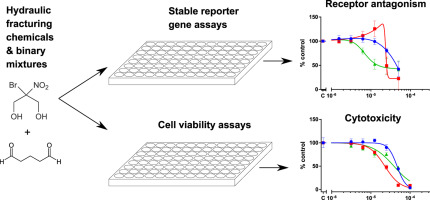Chemosphere ( IF 8.1 ) Pub Date : 2018-01-09 , DOI: 10.1016/j.chemosphere.2017.12.057 Peter A. Bain , Anu Kumar

|
The widespread use of hydraulic fracturing (HF) in oil and gas extraction operations has led to concern over environmental risks posed by chemicals used in HF fluids. Here we employed a suite of stable luciferase reporter gene assays to investigate the potential for selected HF chemicals or geogenics to activate or antagonise nuclear receptor signalling. We screened three biocides (bronopol [BP], glutaraldehyde [GA], and tetrakis (hydroxymethyl)phosphonium sulfate [THPS]), a surfactant (2-butoxyethanol), a friction reducer (polyacrylamide), and a coal seam geogenic (o-cresol) for their potential to act as agonists or antagonists of the estrogen receptor, androgen receptor, progesterone receptor (PR), glucocorticoid receptor or peroxisome proliferator-activated receptor gamma (PPARγ). None of the chemicals induced luciferase activity in any of assays used in the study. In antagonistic mode, BP, GA and THPS caused reductions in luciferase activity in the reporter assays at higher concentrations (50–100 μM), while at low concentrations (2–10 μM) GA and THPS enhanced luciferase activity in some assays relative to controls. None of the other tested chemicals exhibited antagonism in the selected assays. In most cases, altered receptor signalling only occurred at concentrations exhibiting cytotoxicity. However, PPARγ activity, and to a lesser extent PR activity, were inhibited by THPS at sub-cytotoxic concentrations. The majority of binary combinations tested exhibited significantly less-than-additive cytotoxicity, and none of the combinations exhibited synergistic cytotoxicity. In summary, the results of the present study indicate that the selected chemicals are not likely to function as direct agonists of the nuclear receptors tested, and only one chemical, THPS was an apparent partial antagonist of two nuclear receptors.
中文翻译:

水力压裂化学品及其二元混合物的体外核受体抑制作用和细胞毒性
水力压裂(HF)在石油和天然气开采作业中的广泛使用已引起人们对HF流体中使用的化学药品带来的环境风险的关注。在这里,我们采用了一套稳定的萤光素酶报告基因检测方法,以研究选定的HF化学物质或地质基因激活或拮抗核受体信号传导的潜力。我们筛选了三种杀生物剂(溴硝酚[BP],戊二醛[GA]和四(羟甲基)phosph硫酸盐[THPS]),表面活性剂(2-丁氧基乙醇),减摩剂(聚丙烯酰胺)和地质成因的煤层(o-甲酚)作为雌激素受体,雄激素受体,孕激素受体(PR),糖皮质激素受体或过氧化物酶体增殖物激活受体γ(PPARγ)的激动剂或拮抗剂。在这项研究中使用的任何测定法中,没有一种化学物质能诱导萤光素酶活性。在拮抗模式下,BP,GA和THPS在较高浓度(50–100μM)的报告基因检测中导致荧光素酶活性降低,而在低浓度(2–10μM)的报告基因检测中,相对于对照,GA和THPS在某些检测方法中增强了萤光素酶活性。 。在选择的测定法中,其他测试的化学物质均未显示出拮抗作用。在大多数情况下,仅在表现出细胞毒性的浓度下发生改变的受体信号转导。然而,在亚细胞毒性浓度下,THPS抑制了PPARγ活性,并在较小程度上PR活性。测试的大多数二元组合显示出明显小于加性的细胞毒性,并且没有一种组合显示出协同的细胞毒性。总而言之,本研究的结果表明,所选的化学物质不太可能充当所测试核受体的直接激动剂,只有一种化学物质THPS显然是两种核受体的部分拮抗剂。











































 京公网安备 11010802027423号
京公网安备 11010802027423号